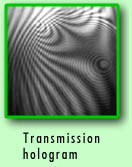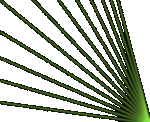|
When
two light waves pass through each other each wave
acts like a bump to the other. And the result is
like rapids of light. The standing wave patterns
are stationary even though the light waves energy
continues to move.  When
waves meet they perform addition and subtraction.
When two waves of equal size meet at their high
points (called crests), they add together to make
a wave twice as high at that point. Conversely,
where two waves of equal size meet at their low
points (call troughs) they addtogether to become
twice as low. And when one wave at its high point
meets another wave at its low point they subtract
and cancel out. But it isn't really cancelled out
in the sense of being destroyed. Its more a case
of there being no light at that spot. If you follow
the wave down its path just a drop further it will
be meeting the other wave at a different relationship
and once again be visible. Its a situation of infinite
possibilities. Just like the patterns possible as
the waves of two pebbles meet in a pond. At any
point you may notice that the standing wave pattern
has produced a place where the waves have added
together to get higher or subtracted to become lower
or even just gone flat. There are few terms that
are used to describe the possible encounters. If
the waves add and get higher its called constructive
interference. If the waves subtract or cancel
altogether its called destructive interference. When
waves meet they perform addition and subtraction.
When two waves of equal size meet at their high
points (called crests), they add together to make
a wave twice as high at that point. Conversely,
where two waves of equal size meet at their low
points (call troughs) they addtogether to become
twice as low. And when one wave at its high point
meets another wave at its low point they subtract
and cancel out. But it isn't really cancelled out
in the sense of being destroyed. Its more a case
of there being no light at that spot. If you follow
the wave down its path just a drop further it will
be meeting the other wave at a different relationship
and once again be visible. Its a situation of infinite
possibilities. Just like the patterns possible as
the waves of two pebbles meet in a pond. At any
point you may notice that the standing wave pattern
has produced a place where the waves have added
together to get higher or subtracted to become lower
or even just gone flat. There are few terms that
are used to describe the possible encounters. If
the waves add and get higher its called constructive
interference. If the waves subtract or cancel
altogether its called destructive interference.
Imagine the
interference pattern as a fingerprint of the encounter of two individual waves. Each
object you make a hologram of creates its own interference pattern that identifies it.
 In
holography, there are two basic waves that come
together to create the interference pattern. First
and foremost is the wave that bounces off the object
we are making a hologram of. Since it bounces off
the object, thereby taking its shape, it is called
the object wave. You can't have interference
without something to interfere with. So a second
wave of light that has not bounced off an object
is used to perform this function. It is called the
reference wave. When an object wave meets
a reference wave creating a standing wave pattern
of interference, it is photographed and called a
hologram. Semi-transparent mirror divides
laser beam into two beams. The first beam which
is called a signal beam, is directed by mirror,
expanded by lens and it illuminates object. The
second beam, called a reference beam, is
also directed by mirror, expanded by lens and it
falls directly onto photoplate. The photoplate registers
an interference pattern between the bearing beam
and the light beam, reflected from the object. A
transmission hologram appears after an
ordinary photo-chemical treatment (hologram of Leith-Upatnieks).
If such a hologram is exposed to a laser light beam,
you may see a 3-d image of the object. The transmission
hologram does not reconstruct the image in ordinary
white light, and it is necessary to copy it to the
reflection hologram.--> In
holography, there are two basic waves that come
together to create the interference pattern. First
and foremost is the wave that bounces off the object
we are making a hologram of. Since it bounces off
the object, thereby taking its shape, it is called
the object wave. You can't have interference
without something to interfere with. So a second
wave of light that has not bounced off an object
is used to perform this function. It is called the
reference wave. When an object wave meets
a reference wave creating a standing wave pattern
of interference, it is photographed and called a
hologram. Semi-transparent mirror divides
laser beam into two beams. The first beam which
is called a signal beam, is directed by mirror,
expanded by lens and it illuminates object. The
second beam, called a reference beam, is
also directed by mirror, expanded by lens and it
falls directly onto photoplate. The photoplate registers
an interference pattern between the bearing beam
and the light beam, reflected from the object. A
transmission hologram appears after an
ordinary photo-chemical treatment (hologram of Leith-Upatnieks).
If such a hologram is exposed to a laser light beam,
you may see a 3-d image of the object. The transmission
hologram does not reconstruct the image in ordinary
white light, and it is necessary to copy it to the
reflection hologram.-->
|





